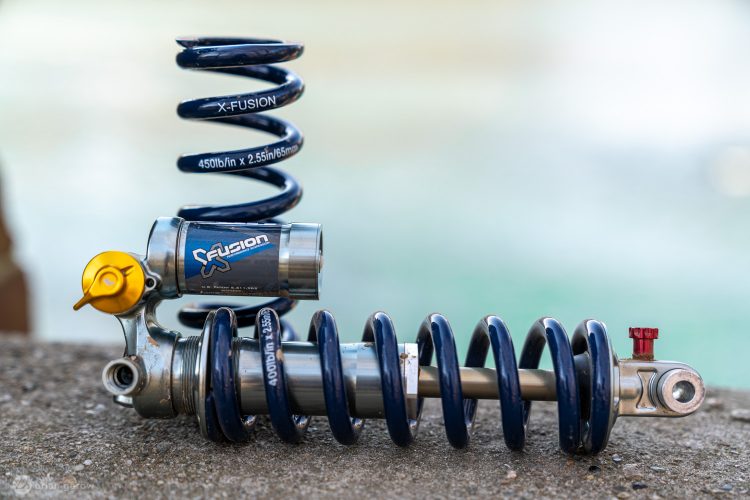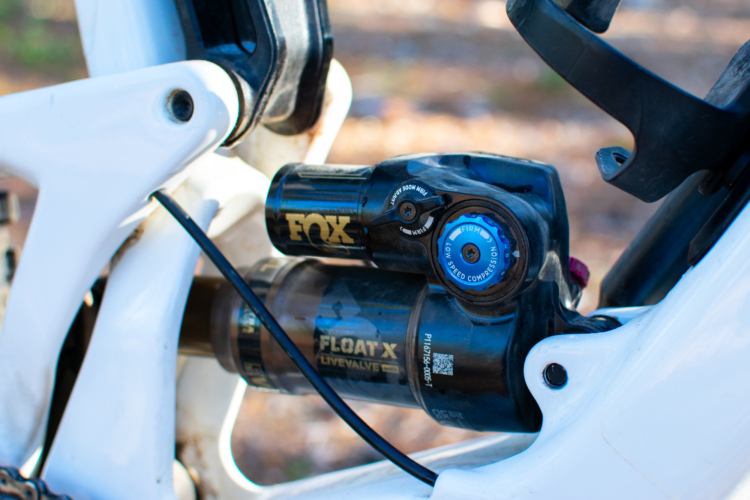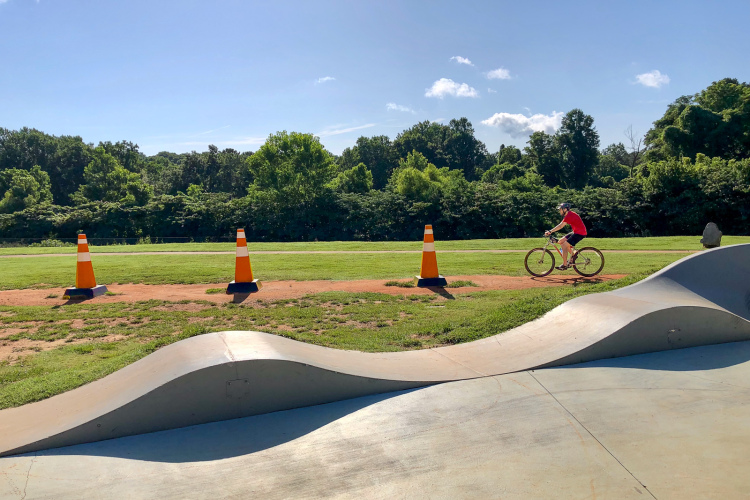
The Cane Creek Tigon is a unique shock that claims to deliver the sensitivity of a coil, the tunability and support of an air spring, and the strength needed to work for certain frame designs that have historically caused issues with coils. After six months of testing, I can confidently say it accomplishes each of these goals in a way that’s particularly compelling for a certain type of trail-focused rider.
Drinking the Coil-Aid
Air shocks have a lot of advantages that have made them pretty ubiquitous in mountain biking. They’re generally light(er), can be tuned extensively to suit different riders and frame designs, and offer progressivity or increased support the deeper you get into a bike’s travel. These characteristics have made them ideal for everything from XC racing to downhill, and they’re much more common than coil shocks as a result.
Still, air shocks aren’t without some disadvantages. The “stiction” created by all the different seals requires a small but measurable force to break, which, combined with progressivity, can create a harsher ride with less small-bump sensitivity. They can also suffer from increased heat buildup on very long descents, resulting in less consistent performance, and the more complex internals have shorter service intervals than their coil counterparts.
All these shortcomings pushed me to dive into the world of coils, but since I’m not generally riding against the clock, I was loath to give up the poppy, playful ride I’m accustomed to with air shocks. When I heard that the Tigon purported to offer the advantages of both, I figured it might be a good opportunity to mix it up on my Specialized Levo, and I’m grateful that the neighborly folks at Cane Creek were willing to share their gateway drug.
While I’ll take most of the blame, the bike industry also makes it easy to forgo coils. It’s a lot simpler for a brand to spec air shocks that can be adjusted to suit any rider and leverage curve design, whereas coils require a spring weight tailored to the individual.
Nevertheless, when I heard that the Tigon promised something a little airier than the typical coil, I was intrigued and figured it might be a good opportunity to mix it up on my Specialized Levo. I reached out, and I’m grateful that the neighborly folks at Cane Creek were willing to share their gateway drug.
Anatomy of the Tigon

At first glance, the Tigon looks like a regular coil shock — it’s got a steel coil spring wrapped around a somewhat portly black-and-gold damper body complete with a piggyback reservoir. Closer inspection reveals some unique features distinguishing it from a run-of-the-mill coil. Most notably, there’s a Schrader valve tucked into the end, feeding air into what Cane Creek calls the RAMP Tube. This is the magic behind the hybrid design: the RAMP Tube is a small, low-volume air chamber nested inside the coil spring. It holds up to 30 psi of air pressure and effectively acts like a secondary air spring within the shock. By adding air to this chamber, you can increase the shock’s progressiveness (the resistance ramp-up in the latter part of travel) by what Cane Creek claims is 20–35% relative to a normal coil shock, depending on your frame’s particular design.
To avoid stiction from the air spring — which, despite the very low pressure, would negate some of the coil’s benefits — Cane Creek included a mechanical negative spring that counteracts it and aids in pulling the shock into its stroke. Since that spring is mechanical, there are half as many seals as you would find in a normal air shock, which also avoids some drag.

So what does all this mean in terms of performance? The coil handles the initial travel and sag, giving the shock that supple feel springs deliver, while the air chamber kicks in deeper in the stroke to prevent bottom-outs and provides a more supportive end-stroke feel than what a linear coil spring would otherwise provide.
Like the rest of Cane Creek’s suspension products, the Tigon relies on a twin-tube damper that utilizes both a main internal piston and an external oil pathway whose characteristics you can adjust via the dials and included allen key magnetically stuck to the shock. Clever. Because the damper tube is oversized and the damper shaft inside it is housed in the middle of the shock instead of off to one end, the Tigon is more resistant to the side-loading that’s exacerbated by clevis-mount frame designs like the one on my Levo.

On the trail
In addition to the shock, Cane Creek also hooked me up with the same red-carpet tuning experience they’ve been offering prospective buyers in the WNC area for about a year and a half. For $200 (that goes to the price of a shock if you decide to buy), some Cane Creek techs will meet up with you, let you demo a shock, and help guide you on your tuning journey — and it’s a journey for sure. The experts I spoke with explained that Cane Creek suspension has historically offered a very wide range of tunability, which can be a double-edged sword. In the right hands, it means that pretty much anyone can find settings that work really well for them. At the same time, an inexperienced rider or one who can’t be bothered to fiddle with dials can get it very wrong and have a sub-optimal experience.
To show me what goes into the demo day they’re offering, we met up at a local bike park called Kanuga. It’s got a little bit of everything, but we agreed the ideal situation would be repeated laps on a dynamic blue trail called GNCC. With some good chunk, a wide variety of corners, and some whoops thrown in for good measure, GNCC encourages a fun, fast pace that worked great for quick, back-to-back comparisons.
To set a baseline, my Cane Creek suspension senseis had me start the tuning process by riding just the spring of the Tigon. That meant no air in the RAMP Tube, no compression damping, and no low-speed rebound damping (HSR is set by the internal shim stack). Right away, I could tell the day was going to be interesting. I weigh about 160lb with riding gear, and I was using a 400-pound spring at 16mm or 29% sag (right in the middle of the suggested 25-35% range). Relying on the spring alone obviously felt a bit noodly and, well, springy, but the improvements in cornering traction produced an immediate lightbulb moment. Normally, learning to really trust a new piece of equipment takes me some time, but halfway down my first lap of GNCC I was loading the bike harder into corners and enjoying a new feeling of control even as the wheels drifted sideways from flat sections of trail into the supportive embrace of small berms.
At the bottom of each lap, I would attempt to describe how the shock felt and how I wanted it to feel, and my pit crew would adeptly translate these intuitions into meaningful adjustments. Over the course of seven laps, it became clear I was looking for something initially soft but ready for repeated hits at speed, and I ended up with the low speed compression three clicks from open, high speed compression a half turn from open, and low speed rebound four clicks from open. I also tried a range of pressures in the RAMP Tube, starting with 5 psi, working up to 15psi in 5 psi increments, and then settling back at just 7.5psi. In the following weeks, as I got to know the shock better, I ended up bumping up my typical pressure to about 10.5psi, but I still adjust it from time to time depending on the feel I’m looking for and the terrain I’m headed to ride. That gradual evolution has definitely been a hallmark of my time on the Cane Creek Tigon.
About six weeks into my now six-month relationship with the shock, I noticed it was feeling harsher than I remembered at the beginning, and I was having a hard time diagnosing the “issue.” Luckily, my annoying but informative friend Strava chimed in to let me know I was riding my usual trails quite a bit faster. After a month and a half of regular and what felt like fairly casual PRs, the original settings weren’t quite cutting it. A slight increase to compression dampening and an additional 2.5psi in the RAMP Tube stiffened things up nicely in the mid-stroke and brought back the supple but supportive feel I had initially been entranced by.
The cost of a coil
If there was one area where I did begin to notice some of the drawbacks of a coil, it was in pedaling efficiency. It’s of course a moot point on gravity-focused trails, but in areas with more meandering flat sections, the suppleness of the spring smoothed bumps out while also absorbing some speed that I was used to carrying with an air shock that’s firmer on the top and more responsive to pumping. Of course, one of the main selling points of the Levo is the motor, and in scenarios like this where speed is free or at least very cheap, I have a hard time imagining why I would go back to an air shock.
The equation changes a little on an analog bike that you’re relying on to do a bit of everything, including long days in the saddle. While the climb switch does a great job of adding efficiency by restricting the flow of oil through the whole damper system, it’s not really something you’re going to use to preserve momentum on short, flat sections between descents.
Despite the drawbacks to efficiency, there’s also good news: after months of exclusively riding the Cane Creek Tigon, I convinced myself to get some exercise and noticed I brought some of the things I had learned from the coil over to the Fox X2 on my trail bike. The shock hadn’t changed a bit during the period of neglect, but it responded well when I attacked corners and just generally expected it to deliver more grip than I ever would have asked for. The Tigon taught me that, in situations where I used to think I was on the edge of traction, I actually still had a bigger reserve left to explore.

Final impressions
If you really want to progress your riding, you’ll inevitably find yourself chasing some product hype at one point or another. It’s tempting to seek out the unequivocal “best” option in a certain category to make sure you’re getting every advantage possible out of your equipment, and there’s a ton of media feeding into that by purporting to tell you the “best” tires, best shocks, best enduro bike, and on and on.
The more ambiguous and less satisfying reality is that what’s best almost always depends, not just on your bike and local trails but in large part on you — what you’re wanting to get out of a product and, in some cases, what you’re willing to put in. After years of a largely set and forget approach to air shocks, I’ve been blown away by the Tigon. While I have zero qualms saying it’s a great product, I’m even more confident that it’s been a great fit for me. The shock met me exactly where I was as a rider by working adequately with my existing strengths (pop and play) while doing some heavy lifting to shore up persistent weaknesses (loading the shit out of corners).
Suspension will pretty much always be a compromise, which is why it’s critical to think about your riding and honestly assess not just where you aspire to be but where you currently are. The Cane Creek Tigon doesn’t break the laws of physics, but it does uniquely blend some of the pros and cons of the different shock styles in a way that I think could win over a solid portion of the air shock camp. And while the sticker price is a big bet on something you’re not sure about, the $200 demo day offers a much more approachable option for people who live or travel to western North Carolina’s world-class trails. (And come see us, we need you these days.)
When I met up with them back in December, Cane Creek reported they had never done a demo that didn’t end in a shock sale. After the experience I had with the product and personnel, that’s not all that surprising. Moving from an air shock to a well-tuned Tigon was easily the biggest character change a component has produced on one of my bikes, and in my case, it was an awesome upgrade.
Pros
- Offers many coil advantages while preserving liveliness
- High degree of adjustability
- Very small weight penalty over Fox X2 or similar air shocks
Cons
- Requires a digital shock pump to make tiny adjustments
- Loss of some pedaling efficiency and momentum on flat sections













8 Comments
Jun 11, 2025
Jun 11, 2025
Glad you've had a great experience as well.
Jun 4, 2025
Jun 11, 2025
Enjoy the Rail! Heard good things.
Jun 4, 2025
Jun 11, 2025
Jun 5, 2025
Jun 11, 2025